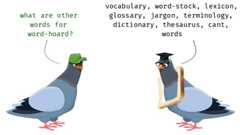Uh oh!
There was an error while loading.Please reload this page.
- Notifications
You must be signed in to change notification settings - Fork11
This Python module can be used to obtain antonyms, synonyms, hypernyms, hyponyms, homophones and definitions.
License
johnbumgarner/wordhoard
Folders and files
| Name | Name | Last commit message | Last commit date | |
|---|---|---|---|---|
Repository files navigation
Textual analysis is a broad term for various research methodologies used to qualitatively describe, interpret and understand text data. These methodologies are mainly used in academic research to analyze content related to media and communication studies, popular culture, sociology, and philosophy. Textual analysis allows these researchers to quickly obtain relevant insights from unstructured data. All types of information can be gleaned from textual data, especially from social media posts or news articles. Some of this information includes the overall concept of the subtext, symbolism within the text, assumptions being made and potential relative value to a subject (e.g. data science). In some cases it is possible to deduce the relative historical and cultural context of a body of text using analysis techniques coupled with knowledge from different disciplines, like linguistics and semiotics.
Word frequency is the technique used in textual analysis to measure the frequency of a specific word or word grouping within unstructured data. Measuring the number of word occurrences in a corpus allows a researcher to garner interesting insights about the text. A subset of word frequency is the correlation between a given word and that word's relationship to either antonyms and synonyms within the specific corpus being analyzed. Knowing these relationships is critical to improving word frequencies and topic modeling.
WordHoard was designed to assist researchers performing textual analysis to build more comprehensive lists of antonyms, synonyms, hypernyms, hyponyms and homophones.
Install the distribution via pip:
pip3installwordhoard
Please reference theWordHoard Documentation for package usage guidance and parameters.
This package is currently designed to query these online sources for antonyms, synonyms, hypernyms, hyponyms and definitions:
- classicthesaurus.com
- collinsdictionary.com
- merriam-webster.com
- synonym.com
- thesaurus.com
- wordhippo.com
- wordnet.princeton.edu
This package has these core dependencies:
- backoff
- BeautifulSoup
- deckar01-ratelimit
- deepl
- lxml
- requests
- urllib3
Additional details on this package's dependencies can be foundhere.
If you would like to contribute to theWordHoard project please read thecontributing guidelines.
Items currently under development:
- Expanding the list of hypernyms, hyponyms and homophones
- Adding part-of-speech filters in queries
This repository is actively maintained. Feel free to open any issues related to bugs, coding errors, broken links or enhancements.
You can also contact me atJohn Bumgarner with any issues or enhancement requests.
If you would like to contribute financially to the development and maintenance of theWordHoard project please read thesponsorship information.
The MIT License (MIT). Please seeLicense File for more information.
Copyright (c) 2020 John Bumgarner
About
This Python module can be used to obtain antonyms, synonyms, hypernyms, hyponyms, homophones and definitions.
Topics
Resources
License
Code of conduct
Contributing
Security policy
Uh oh!
There was an error while loading.Please reload this page.
Stars
Watchers
Forks
Sponsor this project
Uh oh!
There was an error while loading.Please reload this page.
